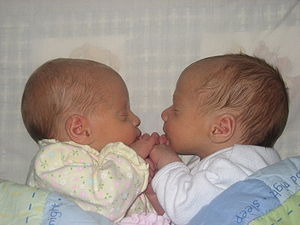How to conceive a boy! - Podcasts powered by Odiogo

How to conceive twin boys?
Your medical practitioner will probably tell you there’s not much you can do to conceive any twins, let alone conceiving the twins of a specific gender. However, there are some things worth knowing if your heart is set on conceiving twin (or multiple!) boys!
What does boost your chances of getting pregnant with twins is:
- a mom-to-be is older,
- it’s not her first pregnancy,
- she’s breastfeeding,
- she has just stopped taking hormonal contraceptives,
- she’s got some extra weight,
- she is on fertility drugs,
- the IVF procedure is done (multiple embryos), and
- dietary factor (maybe).

It is known that those factors that stimulate your ovulation can result in twin conceptions. When more than one egg is released at a time, your chances of getting twins increase considerably.
It is said that eating yams can overstimulate woman’s ovaries, making them more likely to release two eggs. This uppers your chances of having fraternal twins (or triplets, if three eggs are released and fertilized at a time). Give the following foods a try before getting pregnant: walnuts, whole grains, dairy products, eggs, and chicken. Try taking supplements such as cassava root and folic acid (you should take folic acid anyway if you’re preparing yourself for pregnancy).
If you have children already, your likelihood of having twins increases. Not only because the simple law of probability, but because extra weight left from the earlier pregnancies is a contributing factor also. Women who already had twin babies, are more likely to conceive twins again.
If you’re older, your chances of twin conception raise. After 30, the chances of natural twin pregnancy doubles. Please note that we’re still talking about very small percentages (6%) of naturally conceived twins. Women over 45 who successfully got pregnant are having twins in 17% of cases. Among those who are lucky to accomplish pregnancy when 50 or older, one woman in nine will get twins. It looks like our bodies accelerate ovulation as our biological clock is ticking.
Since the older woman are more likely to need help from fertility procedures to conceive, their rate of twin and multiple births is higher. Those that conceive via in vitro fertilization often give birth to multiple babies in one pregnancy, because of a practice to implant more than one embryo to increase the chances of successful conception. The numbers are telling us that almost one in every three to four women who successfully gets pregnant with IVF will get twins.
Fertility drugs that stimulate ovulation, such as Clomid (clomiphene) increase the chances of pregnancy resulting in twins by 10%. Clomid is taken to assist your body to produce more Follicle Stimulating Hormone (FSH) which helps the ovaries to produce one or more mature eggs. Well, it often can be several (hyperovulation)! Hormone shots can also stimulate ovulation.
In some women, immediately after they’ve stopped taking the pill, their ovaries start releasing more eggs. Therefore, you can try to conceive shortly after stopping the contraceptives – this will make you more likely to have fraternal twins.
Women still breastfeeding their children while trying to conceive are more likely to get pregnant with twins.
Of course, if you have a history of twins in your family – or you’re a twin yourself – your chances for twin conception are even better.
More twins are conceived in July. The theory is that it’s due to the effect of the length of daylight on the secretion of Follicle Stimulating Hormone. Babies conceived in January are least likely to be twins. African-American women have a greater chance of having twins than any other race, while Caucasian women have the greatest chance of higher-order multiple births.
Statistically, multiple births make up only 3 percent of all live births but that number is rising rapidly in recent times.
Important: Identical (monozygotic) twins are always either both boys or both girls. Fraternal (dizygotic) twins can be of the same sex, or there can be one of each sex. Identical twins are made when the fertilized egg for some reason splits in two, so both parts develop individually, sharing the same placenta and the genetic makeup. Fraternal twins are created when two eggs are released, and they both get fertilized by different sperm, then implanted, and developing in separate placenta.
They are more common than identical twins, and it’s said they’re easier to “makeâ€. So happy babymaking!:) Remember though that twin pregnancies, and especially multiples, tend to be more complicated than regular pregnancies.






 Visit Podcast Website
Visit Podcast Website RSS Podcast Feed
RSS Podcast Feed Subscribe
Subscribe
 Add to MyCast
Add to MyCast